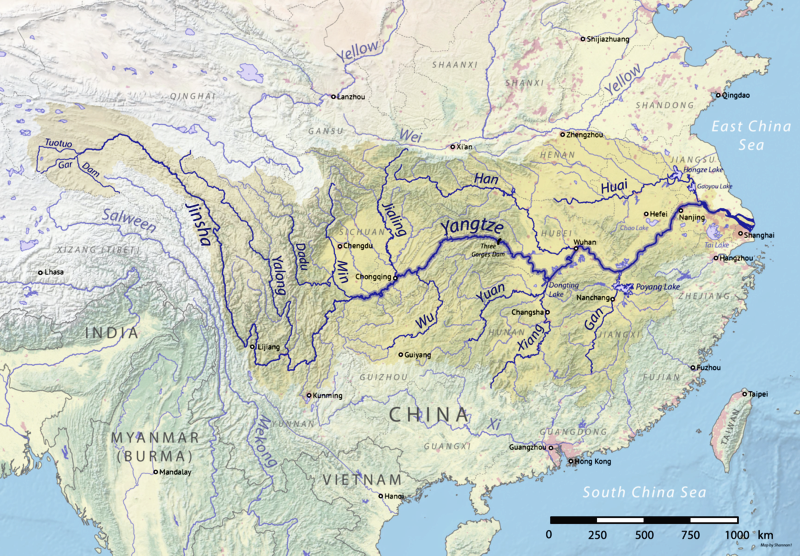 Pirates and Privateers Pirates and Privateers
The History of Maritime
Piracy
Cindy Vallar, Editor
& Reviewer
P.O. Box 425,
Keller, TX 76244-0425
    
Samurai, Scholar, Poet, Prince, & Pirate
A Family Affair
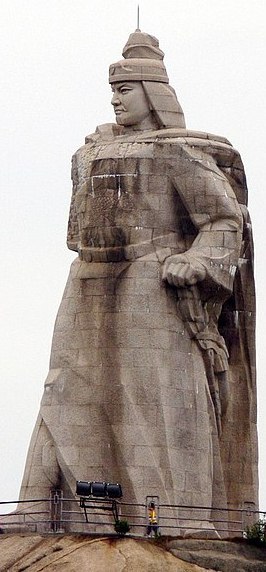
Guóxìngyé (Koxinga or
Zheng Chenggong) by Gisleng
(source: Wikimedia
Commons)
Ming society was divided into five
classes. At the top, as in many cultures,
was the nobility. In China, the other four
were known as the shi, the nong,
the gong, and the shang.
Of these, the nong were a key
component because they were farmers and
their products made it possible for
everyone else to live. When practicing
legitimate trade, the Zheng clan were
members of the shang because they
were merchants. Zheng
Zhilong held much power and
influence as one of the shang because
of his wealth and his ability to achieve
his goals. But he wished for his eldest
son to have higher aspirations. He wished
him to be part of the gentry, the ruling
class of Chinese society – a member of the
shi.1
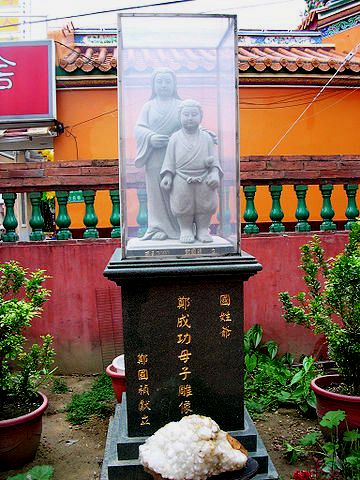 This wish, however, was
not an immediate one. When his son was
born in 1624, Zheng Zhilong was absent
from Japan. His son’s mother, Tagawa
Matsu, was the daughter of a minor samurai
and was forbidden to leave her homeland.
Instead, she and Lucky Pine (Fukumatsu)
lived on Hirado
Island, which was ruled by the Tokugawa
Shogunate. This wish, however, was
not an immediate one. When his son was
born in 1624, Zheng Zhilong was absent
from Japan. His son’s mother, Tagawa
Matsu, was the daughter of a minor samurai
and was forbidden to leave her homeland.
Instead, she and Lucky Pine (Fukumatsu)
lived on Hirado
Island, which was ruled by the Tokugawa
Shogunate.
Living with his mother and her family
meant that Lucky Pine was raised to be a samurai warrior.
Two key components of this upbringing were
loyalty to one’s ruler and being virtuous
in all that one did.2
This philosophy was somewhat at odds with
the teachings
of Confucius, which his father
followed, and placed obedience to the
family, especially the father, above all
else.
Hints of this divide between son and
father would surface in adulthood. One
example would appear in a letter Lucky
Pine eventually write to Zheng Zhilong.
In ancient times,
righteousness was always more valued
than family loyalty . . . and ever
since I learned to read I always
admired the righteousness of the
Spring and Autumn Period.
(Andrade, Lost, 63)3
The second
instance came in his reply to a Manchu
offer to join them as his father had. “I
cannot trust in the words of barbarians. I
will not deal with a collaborator.”
(Clements, 144) One of his undated poems
further supported this divide:
I most pity how difficult
it is to fulfill the two obligations
of loyalty [to the ruler] and filial
piety. Whenever I think of my father’s
residence, tears flow in the four
directions. (Xing, Conflict,
73)
Lucky Pine’s
training, which included martial arts and
learning to read and write, began around
the age of two or three for boys destined
to become samurai. One of the few
surviving artifacts of Lucky Pine’s early
life is a painting made when he was six or
seven years old. His hair is long. He
stands straight, with his legs having a
slight bow. He holds a katana,
a curved sword about two feet long with a
sharp-edged blade and a wood handle
covered in ray skin and braided with blue
silk.

Example of a
katana sword. This one, made by Muramasa in
the 16th century,
is on display in the Tokyo National Museum.
Photo by Ihimutefu.
(Source: Wikimedia
Commons)
Life changed abruptly for Lucky Pine when
he was seven. His father decided it was
time his son came to live with him in
China, and so he left his mother behind
and moved from a modest Japanese house
into an opulent palace with pavilions,
tea-houses, and a zoo of exotic animals –
all contained within a walled enclosure.
When Lucky Pine stepped off the junk that
brought him to his new home, his father
called him Zheng Sen (Forest or Big Tree).
Zheng Sen’s studies continued but now
included Confucius’s teachings and ancient
history in addition to furthering his
training in combat and self-defense. His
father believed that if Zheng Sen mastered
his studies and passed as many of the four
levels of the civil
service examinations as possible, he
would become a member of the shi and
thus bring legitimacy to the Zheng clan.
Zheng Sen loved learning. He particularly
liked to delve into Sunzi’s
military treatise, Bingfa (The
Art of War). Within four
years, he thoroughly comprehended one of
the most difficult works in Chinese
literature: Annals of the Spring
and Autumn Period. These
chronicles focused on fidelity, integrity,
courage, and morality. At fourteen, he
successfully underwent the first civil
service examination. According to one
scholar, Zheng Sen was “no normal boy.
He’s a person of destiny, an outstanding
talent.” (Andrade, Lost, 63)
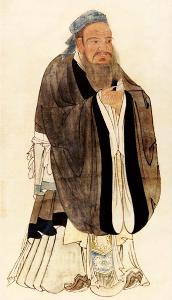 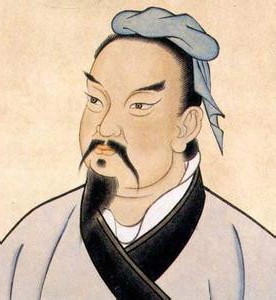
Left:
Confucius painted by Qiu Ying during the
Ming dynasty (Source: Wikimedia
Commons)
Right: Sun Tzu painted by unknown artist
during the Qing dynasty (Source: Wikimedia
Commons)
He later passed the third level, which was
given at the provincial capital. This
achievement made him part of the
provincial elite. Should he continue, the
fourth level exam would take place at the
imperial palace. If he passed that, he
would be considered one of the shi.
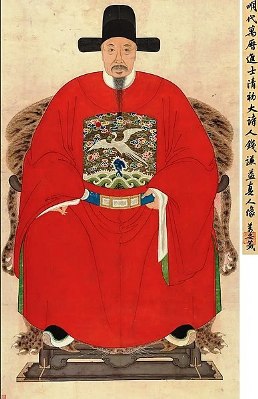 Toward that end, he went to
Nanjing,
a center of learning, in 1639. There he
studied under the esteemed Qian
Qianyi, a poet and historian. Zheng
Sen continued to learn about ancient
poetry, historic battles, and heroes. His
studies also taught him about conducting
affairs of state, diplomacy, and being a
gentleman. Much of his learning had to be
memorized, and he excelled in his studies. Toward that end, he went to
Nanjing,
a center of learning, in 1639. There he
studied under the esteemed Qian
Qianyi, a poet and historian. Zheng
Sen continued to learn about ancient
poetry, historic battles, and heroes. His
studies also taught him about conducting
affairs of state, diplomacy, and being a
gentleman. Much of his learning had to be
memorized, and he excelled in his studies.
What he could not control was the upheaval
afflicting China during this period. One
crisis after another plagued the Ming
emperor. One involved the economy. Another
concerned the natural disasters that were
taking a toll on the people. Unrest
rippled through the empire, and the
greatest threat came from the northeast
where the Manchu rebelled. As they
advanced into Ming China, Zheng Sen had to
curtail his studies and leave Nanjing.
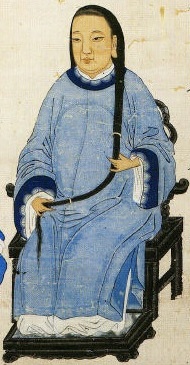 Even with this upheaval,
Zheng Sen married his first wife in 1641.
He did not choose his bride; he took her
to please his father. Dong Cuiying came
from a wealthy family, but her behavior
and priorities did not mesh well with his.
She had been spoiled growing up and it was
best not to be on the receiving end when
her temper was riled. She also loved the
latest styles. Despite their differences,
Zheng Sen dealt with his new
circumstances. The following year, he
welcomed a son, Jing, to his family. Even with this upheaval,
Zheng Sen married his first wife in 1641.
He did not choose his bride; he took her
to please his father. Dong Cuiying came
from a wealthy family, but her behavior
and priorities did not mesh well with his.
She had been spoiled growing up and it was
best not to be on the receiving end when
her temper was riled. She also loved the
latest styles. Despite their differences,
Zheng Sen dealt with his new
circumstances. The following year, he
welcomed a son, Jing, to his family.
The Zheng were loyal defenders of the Ming
dynasty, and Zheng Sen’s fidelity was
eternal. He proved himself a skilled
warrior, wielding his katana with deadly
accuracy. His proficiency extended to
other weapons as well: bow and arrow,
halberd, lance, arquebus, and musket.
When the Manchu seized Beijing in June
1644, the Ming ruler was Zhu
Youjian. Known as the Chongzhen
Emperor, he hadn’t been trained to be the
ruler and didn’t initially want the title,
but he tried to be a good ruler. Rather
than surrender to the rebels, he committed
suicide. Afterward, loyalists fled south
to try to reestablish the dynasty, which
became known as the Southern
Ming dynasty. A series of claimants
ruled – the Hongguang
Emperor, the Longwu
Emperor, the Shaowu
Emperor, and the Yongli
Emperor being the most important –
between 1644 and 1661.
Zheng Sen’s loyalty and defense of the
Longwu Emperor (Zhu Yujian) received
special recognition. The emperor “adopted”
Zheng Sen, treating him as if he were a
son-in-law and bestowing upon him the
imperial surname Guóxìngyé. He was also
given the name Chenggong (success), as
well as an imperial sword and seal on
which were engraved the Chinese words for
“Great Rebel Quelling General.”
Although he was now Zheng Chenggong, Zheng
Sen preferred to be called as the emperor
called him, Guóxìngyé, which Westerners
anglicized as Koxinga (sometimes spelled
Coxinga). He would become the Ming
dynasty’s last defender.
The Manchu
established their own dynasty, Qing,
but their armies did not stop once they
reached Beijing. Their soldiers continued
south and took Anhai, the city where
Koxinga’s mother now made her home.4
Accounts disagree on what transpired, but
Tagawa Matsu died in 1646.5
Her daughter-in-law, Cuiying, must have
been present or close by at the time of
the attack, because she risked her life to
save the ancestral tablet belonging to her
mother-in-law while other Zheng family
members fled.6
With his mother’s death, this tablet also
served to venerate her and Cuiying’s act
demonstrated to Koxinga that she was more
loyal than those born with Zheng blood.
Thereafter, she became his closest friend.
He valued her counsel on many things,
including affairs related to his military
ventures and the Zheng family.
When his father decided it was better to
join the winning side, rather than
continue supporting a losing cause, he
didn’t consult Koxinga, or anyone else in
the family. Koxinga would write:
How is it that my father,
who has always taught me the virtue of
loyalty, can contemplate such as
ignominious surrender? How can my
father expect his son to be called a
traitor? (Clements, 130)
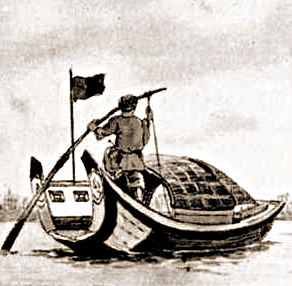 Feeling
betrayed, Koxinga struck out on his own.
“In the past I was guided by my relatives,
but now I am alone.” (Clements, 133) He
also believed that he was entitled to
control the vast empire that his father
had created, although many within the
Zheng clan disagreed. As a result, Koxinga
had only one sampan,
silver equivalent to 1,000 taels, and
several dozen followers. Feeling
betrayed, Koxinga struck out on his own.
“In the past I was guided by my relatives,
but now I am alone.” (Clements, 133) He
also believed that he was entitled to
control the vast empire that his father
had created, although many within the
Zheng clan disagreed. As a result, Koxinga
had only one sampan,
silver equivalent to 1,000 taels, and
several dozen followers.
Although he had studied Chinese military
and naval history and practices, Koxinga
lacked experience. But he was stubborn and
believed in the rightness of what he did.
He was also ruthless in managing his
resources; instead of showing favoritism,
he rewarded those who deserved advancement
through their actions. Nor was he a
commander who led from the rear. He placed
himself in the front line, and even when
wounded, he was a force to be reckoned
with. He was also determined to defend the
Ming cause with his life if necessary. He
eventually increased his ranks to 300 and
several commanders who had once followed
his father joined Koxinga. Their initial
battles against the Qing ended in defeats,
but each loss taught him valuable lessons.
During this time, a revenue collector
joined Koxinga’s ranks. Yang Ying kept a
journal that somehow managed to survive
Qing attempts to purge all evidence of the
Zhengs’ existence. Entitled True
Record of the Past King’s Expeditions,
Yang Ying revealed much about Koxinga’s
strategies. Locals taught him about their
terrain, which enabled him to find the
best places to ambush the enemy. He taught
his men to pretend to be weak in order to
draw out their opponents. Then his men
attacked them from the sides, dividing the
enemy into two smaller forces. His tactics
proved so successful that after routing
one village, two others quickly
surrendered.
One early example of these successful
strategies came in 1648 when he targeted
the port of Tongan. The Manchu expected a
sea assault and fortified the garrison and
town. Several days before Koxinga’s ships
appeared, four squads of his men, in the
guise of wandering monks, infiltrated the
city. They waited until Koxinga sent fire
ships into the harbor, at which time they
slew the sentries and threw open the
gates. Zheng foot soldiers stormed inside.
Not all the spies succeeded in carrying
out their orders, but the majority did and
Koxinga took the port while his men
slaughtered any Manchu they encountered.
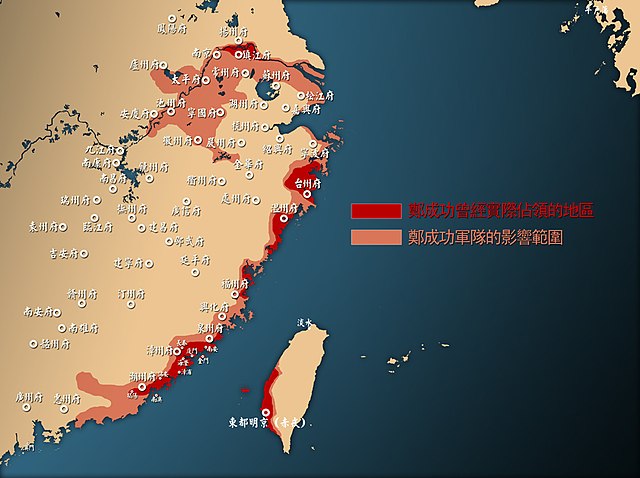
Territory Koxinga came
to control during his lifetime.
Red signifies areas he held. Pink
signifies his sphere of influence.
(Source: Wikimedia
Commons)
Although he had forsaken the cap and robe
of a scholar when he chose to fight,
Koxinga still wrote poetry. One poem was
written around this time, and was later
recorded in the Historical Novel of
Taiwan.
The year has brought great
joy and profound sorrow
Yet if a
man works hard for fortune or fame,
Death will
not spare him.
As with
idle sports, in the end all is vain
Though
men’s hearts may be blind
The Way of
Heaven rewards the true of heart
If my life
must be a game of chess
I am not
afraid of the final move
Let the
people say what they will
It is not
easy to be an honest man
In a
distressed and wicked time.
(Clements, 133)
Now that he had
succeeded in furthering the Ming cause,
Koxinga decided to reclaim his father’s
empire. In slightly more than twenty-four
hours in the fall of 1650, he captured
Xiamen, China’s most important port and
succeeded in gaining control of the Zheng
organization. Under his leadership, their
financial empire grew. Koxinga combined
legitimate and illegitimate commercial
ventures just as his father had. His ships
attacked and plundered other vessels and
towns. Additional funds came from
ransoming captives. In 1657, Zheng pirates
struck the prefect (district) of Xinghua.
Villages were plundered, women were
assaulted, children were kidnapped, and
more than 1,000 lost their lives.
Koxinga also charged baoshui (water fee)
on any vessel that wanted to sail in
Fujian waters. It didn’t matter whether
they were Chinese boats or foreign ships;
each had to pay. Refusals resulted in
piratical attacks. The Zheng clan’s
control eventually extended to all the
trade between Fujian and Guangdong, as
well as most foreign commerce with
Southeast Asia, the Dutch on Taiwan, and
the Spanish in the Philippines. Between
1650 and 1662, the average annual income
of Koxinga’s operations amounted to
4,000,000 taels of silver (150 tons). This
was double the annual revenue of the Vereenigde
Oostindische Compagnie (VOC,
or East India Company), and the Dutch were
Koxinga’s greatest competitors. Koxinga
utilized much of the garnered wealth to
fight the Manchu.
The situation in China worsened. Wang
Yingyuan, a government official touring
the province of Fujian in 1652, reported:
In the eighth and ninth
lunar months . . . the price of rice
had risen to 150 taels per picul. The
people had run out of grasses, roots,
wood, and leaves, as well as mice,
sparrows, water buffalos, and horses.
In their desperate search for food,
nothing was left but human flesh.
Fathers and sons ate one another, and
those who had not ended up in the
stewpot died of diseases or hunger.
[Others] drowned or hung themselves .
. . . Everyday thousands died. The
bodies piled up and the stink could be
smelled for several li away.
(Calanca, Elusive, 89-90)
The following
year an epidemic swept over the land. An
earthquake and a plague of locusts struck
in 1654. The strife between Qing and Zheng
forces also impacted trade. Confronted by
all these difficulties, the Manchu decided
to employ Zheng Zhilong to bring Koxinga
to heel; otherwise, what use was this
turncoat?
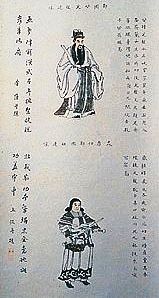 His father
wrote two letters to Koxinga, saying the
Manchus wished to meet and discuss terms
of peace. The second missive included this
passage: “The Manchu court offers
territory in exchange for peace. They wish
to send two noblemen to present you with
the title and deeds of the Dukedom of
Haicheng, allowing your followers to abide
in the region.” (Clements, 149) His father
wrote two letters to Koxinga, saying the
Manchus wished to meet and discuss terms
of peace. The second missive included this
passage: “The Manchu court offers
territory in exchange for peace. They wish
to send two noblemen to present you with
the title and deeds of the Dukedom of
Haicheng, allowing your followers to abide
in the region.” (Clements, 149)
Acceptance never crossed Koxinga’s mind.
For eight years now . . . my
father has not regarded me as his son.
I return the sentiment. Communications
have ceased, and we have not exchanged
a single word since. Since ancient
times, sane and righteous men have
understood that there is a greater
duty than mere loyalty to one’s
family. I have known this since I
first learned to read it in the Spring
and Autumn Annals. It was on my mind
in [1646] when my father drove up to
the capital. I made my decision then.
Now, all
of a sudden, you seek to lecture me on
loyalty. You, who are a mouthpiece for
the Manchus, talk of promoting me
above the former ranks of earl and
marquess. But since the Manchus have
lied to you, what makes you think they
do not lie to me? (Clements, 150)
The Manchu
refused to be put off by this response and
tried again. Two emissaries arrived with
this proposal:
Even with the pacification
of coastal regions, We would still
require the competent organisation of
defences. Rather than search for
another, would you not seem to be the
ideal candidate? Your father remains
confident in his family, and has
recommended you highly . . . You may
repel and destroy pirates at your
discretion. You retain the
responsibility for inspection and
taxing of maritime cargo . . . You
shall achieve the pacification of the
seas. Such is Our inevitable command.
(Clements, 151-2)
The governor of
Fujian, who had also forsaken the Ming
emperor, sent his own note in hopes of
swaying Koxinga.
Your father has been
promoted in status above the highest
minister, but your grandmother is
frail in years. [The Manchu hold the
territory] where can be found your
ancestors’ graves, though you of
course do not require burial there
yet. If your continued military
actions were to cause harm to come to
those tombs, it would cause unbearable
stress to your honoured father. Even
in his dreams, he would not get a
moment’s peace, nor would your
grandmother have a quiet moment to
sleep or eat. (Clements, 152)
Koxinga’s reply
was:
Who would have thought, so
soon after the desecration of my
ancestral tombs, that such grand
embassies would arrive, heavy with
silken, heartfelt sincerity? How could
I refuse such offers? I’ll be waiting
for you. Maybe with a little present.
(Clements, 153)
Next came two
of his younger brothers. They claimed
their father would be killed if Koxinga
didn’t parley with the Qing. He replied:
You youngsters don’t know
the ways of the world . . . . Father
is only safe as long as I am at large.
If I shave my head and accept the
Qing’s deal then father and you will
be headed for ill fates. Stop speaking
to me of these things! Do you think it
easy to deny my humanity and abandon
my father? Doing the right thing is
not easy! It’s not easy! (Andrade,
Lost, 79-80)
Zheng Zhilong
wrote again in 1655, this time without
permission from his keepers. The Manchu
intercepted it and their reaction was
swift. They sentenced him to death.
Koxinga decided to
assail Nanjing
in 1568. A vast fleet of vessels set sail
for the Yangtze
River. Not only did these vessels
carry his sailors and soldiers, but also
present were many members of his
household, including at least one
concubine (maybe even six) and two of his
young sons. Vittorio Riccio, an Italian
missionary, claimed “[i]t was the most
powerful fleet that had ever been seen in
the Chinese seas.” (Andrade, Lost, 86)
Although estimates and accounts disagreed
on numbers, Riccio described it as “a
shocking and awesome sight . . . The fleet
occupied the waters in such a way that the
ocean looked like an immense forest of
bare trees.” (Andrade, Lost, 86)
Map of the Yangtze River by
Shannon1. (Nanjing is about 1 inch inland
from the mouth of the river)
(Source: Wikimedia
Commons)
Koxinga never
reached his target. A fearsome storm
struck. Waves crashed over the decks. The
rain was so heavy the helmsmen couldn’t
steer and the navigator could not see
hidden dangers. The winds drove ships into
each other. Others crashed into reefs that
ripped open their bottoms. Still more were
smashed on the rocks. The number of ships
lost was never revealed, but estimates of
those who died reached 8,000. That number
included 231 members of his household,
some of whom were his immediate family.
Numerous survivors saw the disaster as
evidence that the sea goddess no longer
favored the Zheng and deserted or joined
the Manchu.
Another attempt was made in 1659. This
force was even bigger, but it was
destroyed by the Manchu, in part because
Koxinga ignored advice from a local
advisor familiar with the region and the
enemy. Koxinga withdrew but refused to
stop fighting the invaders.
More determined than ever, the Qing opted
to use a multi-pronged approach to succeed
in stopping Koxinga. To implement this
plan, they selected Huang Wu to lead them.
Once a Zheng officer, he knew their
vulnerabilities. Support for Koxinga had
to end. This meant attacking the family.
First, Zheng Zhilong was executed. Next,
Zheng family tombs were destroyed so that
the spirits of their ancestors would no
longer be able to help them. Smugglers who
supplied the Zheng were quickly
dispatched.
Then a policy of scorched-earth was
enacted. A wide swath of land near the
shore was evacuated and the people had to
move thirty to fifty li (twelve
to twenty miles) inland. Given only a few
days to leave, this forced exodus was
devastating. Many families had lived in
these homes for generations and living
farther from the coast meant they could no
longer practice the only trade they knew.
Anyone who defied this order and stayed
was slaughtered. Once the region was
abandoned, everything – houses, barns,
shops, crops, and boats – were put to the
torch. The fires created so much smoke
that it blocked out the sun in Xiamen for
three days. One survivor of this ruthless
policy wrote this poem:
Cold day, at sunset: husband
and wife hold each other as they walk.
Where will
they find solace? Hiding their faces,
they weep on the roadside.
Barbarian
riders drive them away; the ultimatum
is unyielding.
Determined
they are, to reduce the coastal earth
to bare grass.
The rich
suddenly became poor – and the poor,
who will help them?
No deep
seas are left to fish, no broad fields
left to farm.
The inland
regions are full of distress folk;
girls and women in the family quarrel
without end.
The mob
turns easily to violence, crowded as
they are with the starving.
I hear that
they are building a great trench and
guarding it with soldiers and
wardrums.
They guard
the ocean like guarding a frontier;
and the old and young toil and suffer.
This
suffering overflows all feelings – who
can stop this flood? (Ho, 205-206)
Hundreds of
thousands were left homeless and hungry,
and Koxinga was deprived of a safe base
from which to operate. He and his people
needed a new land to go to, and he chose
the island of Taiwan
as his new home. The only problem was that
it was occupied by the Dutch. Koxinga
determined that they would have to leave;
he gathered 300 to 400 junks and 25,000
men and set sail for Fort
Zeelandia.
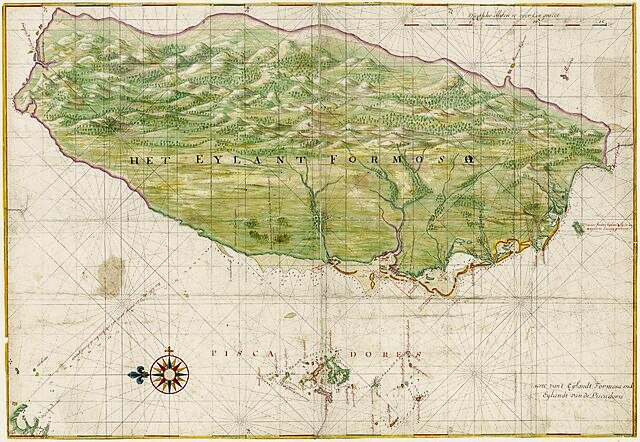
1640 map of Formosa
(Taiwan) and the Pescadores.
The orientation has the west coast of
the island facing the bottom of the
picture.
(Source: Wikimedia
Commons)
Rumors of a possible invasion had first
reached the Dutch in early 1660. Twelve
VOC ships from Batavia arrived in July to
defend the island, but when no enemy
troops came, the majority of commanders
left for home on two ships. In April 1661,
the Dutch first spotted the sails of the
approaching invaders’ force. At the time,
a total of 1,733 lived within the confines
of the fortress. This number included 218
women and children, as well as 547 slaves
and their offspring. The men totaled 968,
the majority of whom were soldiers and
their officers. The fort was built to hold
only about 575 people.
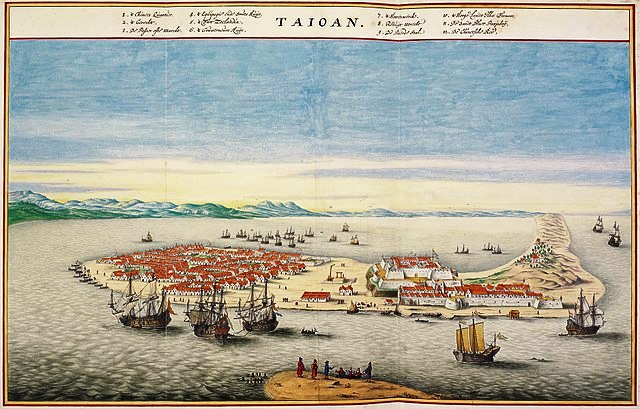
17th-century watercolor
by Joan Blaeu of the VOC's Fort
Zeelandia on Formosa (Taiwan).
(Source: Wikimedia
Commons)
One might think the VOC and the Dutch
would have the edge, but Koxinga had the
latest weaponry and a cadre of
well-trained musketeers from Africa. He
also possessed insider knowledge, provided
by a defector named Pinqua. What ensued
was a siege that lasted nine months. Both
sides suffered because of internal
“conflicts, hunger, poverty, and large
numbers of deaths.” (Blussé, 230)
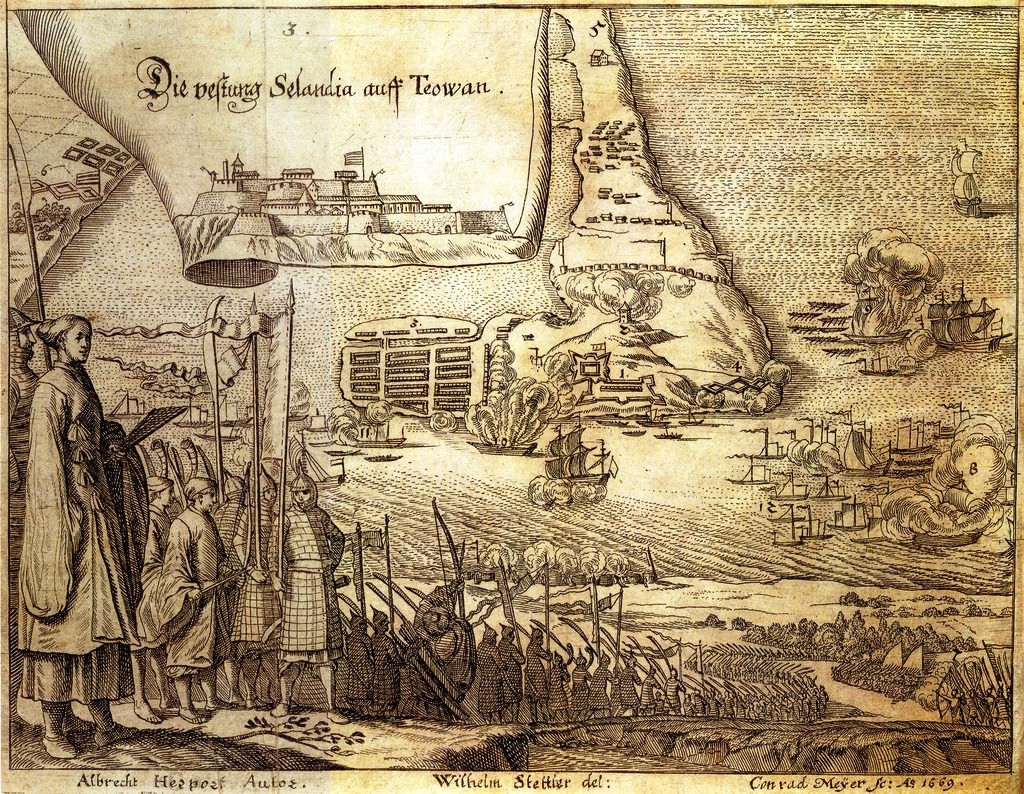
Die Festung Selandia
auff Teowan (The Siege of
Zeelandia on Taiwan) by Albrecht
Herport, 1669
(Source: Wikimedia
Commons)
One of those disputes involved Koxinga and
his uncle, Zheng Tai, who managed the
Zheng overseas operations. Rather than
stick around until the siege ended, Zheng
Tai returned to China. The desertion
enraged Koxinga so much that he forgot
“his blood-tie and the many expressions of
friendship and fatherly assistance which
his uncle had given him” and literally
demanded his uncle’s head. (Blussé, 230)
Calmer heads prevailed and the order was
not carried out; it was a sign that all
was not copacetic. Such rants were not
unknown to those who knew Koxinga. He
needed and wanted to control all aspects
of his domain, and when things did not go
as planned or people failed to heed his
orders, his temper flared in the extreme.
When he conversed with others, his gaze
flitted from one spot to another. Sure
signs that he was angry came when he
became sarcastic or threatened someone and
then gave a false, but terrifying, laugh.
When the Dutch finally surrendered on 1
February 1662, only about 900 remained
alive. Unsanitary conditions – rank smell,
filth, illness, no water, hunger – had
resulted in approximately 1,600 dead. The
survivors were malnourished and permitted
to take only themselves, the clothes on
their backs, and their account ledgers
with them when they left the island. All
weapons, ammunition, money, and goods
became the property of the Zheng clan. The
Chinese who remained outside the fort
didn’t fare much better than the Dutch.
Food had become scarce – at one point,
Koxinga ordered that each soldier could
only have the equivalent of 1,750 calories
a day, which he then had to share with his
family and servants – and disease spread
unhampered.
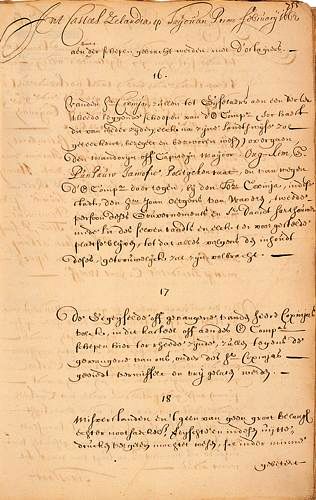 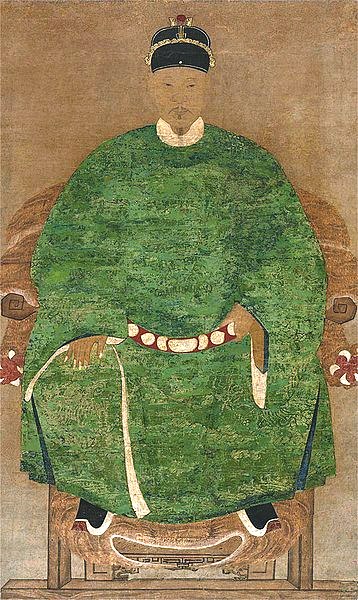
Right: Treaty between
Koxinga and the Dutch following their
surrender in 1662 (Source: Wikimedia
Commons)
Left: Koxinga by unknown
artist, mid-17th century (Source: Wikimedia
Commons)
Although the Qing finally executed Zheng
Zhilong in November 1661, the government
did not make this fact widely known at the
time. Instead, they waited and issued a
proclamation detailing specifics of the
execution the following February, hoping
that the news would reach Koxinga. It did
and it upset him greatly. He declared a
period of public mourning.
News of another death soon reached
Koxinga. The Longwu Emperor had been
captured and killed in 1646. The last
successor to the Southern Ming dynasty was
Zhu Youlang, known as the Yongli Emperor;
although initially successful against Qing
forces, he and his family eventually fled
to the area known today as Myanmar. With
an invasion force massing on his doorstep,
King Pye Min delivered the Yongli Emperor
into the hands of his enemy, a former Ming
general and now a Qing commander and
prince, in 1660. The Yongli Emperor was
strangled to death the following year.
This news reached Taiwan on 12 July 1662.
Overwhelmed with grief, Koxinga arrayed
himself in ceremonial robes, proceeded to
the family shrine, and died. Or perhaps he
succumbed from a seizure following a
dispute with his son. Or it may have been
malaria that claimed him. Regardless of
the cause, Koxinga was dead three days
later.
An ancient prayer amid
yellowing leaves
A palace
open to cold autumn winds
Thicker and
thicker grow the old oak trees
Heedless,
the birds return.
Stone
monuments lie forgotten in the earth
Shrine
steps covered with moss
To this
place, where few visitors come
The
sorrows of the world return.
(Clements, 166-67)
Unlike the
monuments mentioned in this poem that
Koxinga wrote, he was not forgotten.
Although the Manchu initially set out to
eradicate him and the Zheng clan from
memory by destroying graves and all Zheng
writings, the Kangxi Emperor ordered the
restoration of the Zheng graves in 1700.
The Qianlong
Emperor honored Koxinga as a Paragon
of Loyalty in 1787. Even in Japan, the
land of his birth, he has been honored and
remembered. The
Battles of Coxinga (1715)
became one of the most popular kabuki
plays. The honorable samurai Coxinga
defeats the Manchu and returns the Ming
emperor to the throne.
Most of what we know of Koxinga comes from
outside sources: Qing, Dutch, Spanish,
Portuguese, and Japanese. A few
contemporary accounts remain, penned by
those who either took part in Zheng
activities or heard stories and
interviewed those who knew him. Koxinga
had both a private and a public persona,
because he preferred to keep his thoughts
and intentions to himself.
To the Dutch and the Manchu, he was a
pirate. Englishmen and Spaniards
considered him a king. The Chinese used
both words. Koxinga would have said he was
neither. He was a loyal Ming follower who
just wanted to be a scholar.
Notes:
1. The gong consisted
of craftsmen and women who produced the products
used in everyday life.
2. Stories about samurai show
that this warrior would rather commit suicide
than betray his leader or his honor.
3. The Spring and Autumn
Period occurred between 770 and 430 BC during
the Eastern Zhou Dynasty. It was a time of
strife and change. It was also when the great
philosophers (like Confucius, Laozi, and Sunzi)
lived.
4. Zheng Zhilong’s request
for Tagawa Matsu to emigrate from Japan was
granted in 1646. Sometime after she established
her home in Anhai, south of Quanzhou, that year
was when the Manchu invaded Fujian province.
5. Some say the Manchu killed
her; others recount that after they raped her,
she committed suicide. Koxinga found her and
cleansed away any trace of the villains,
reinforcing his deep devotion to her. Her
violation and death also explained his
deep-seated hatred for the Manchu and the Qing
dynasty.
6. Also known as a spirit
tablet, the ancestral tablet was a way to honor
one’s ancestors.
Resources:
“11:18:
Fall of the Ming Dynasty” in Early
World Civilizations. LibreTexts.
Andrade,
Tonio. Lost Colony: The Untold Story
of China’s First Great Victory over
the West. Princeton University,
2011.
Andrade, Tonio, and Hang Xing. “The East
Asian Maritime Realm in Global History,
1500-1700,” Sea Rovers, Silver, and
Samurai: Maritime East Asia in Global
History, 1550-1700. University of
Hawai’i, 2019, 1-27.
Antony,
Robert J. “Introduction: The Shadowy
World of the Greater China Seas” in Elusive
Pirates, Pervasive Smugglers: Violence
and Clandestine Trade in the Greater
China Seas edited by Robert J.
Antony. Hong Kong University, 2010,
1-14.
Antony,
Robert J. Like Froth Floating on the
Sea: The World of Pirates and
Seafarers in Late Imperial South China.
Institute of East Asian Studies,
University of California, 2003.
Blussé, Leonard. “Shame and Scandal in
the Family: Dutch Eavesdropping in the
Zheng Lineage,” Sea Rovers, Silver,
and Samurai: Maritime East Asia in
Global History, 1550-1700.
University of Hawai’i, 2019, 226-237.
Busquets, Anna. “Dreams in the Chinese
Periphery: Victorio Riccio and Zheng
Chenggong’s Regime,” Sea Rovers,
Silver, and Samurai: Maritime East
Asia in Global History, 1550-1700.
University of Hawai’i, 2019, 202-225.
Calanca, Paola. “Piracy and Coastal
Security in Southeastern China,
1600-1780” in Elusive Pirates,
Pervasive Smugglers: Violence and
Clandestine Trade in the Greater China
Seas edited by Robert J. Antony.
Hong Kong University, 2010, 85-98.
Calanca, Paola. “South Fujian the
Disputed Coast, Power and the
Counter-power,” Pirates, Ports, and
Coasts in Asia: Historical and
Contemporary Perspectives edited
by John Kleinen and Manon Osseweijer.
International Institute for Asian
Studies and Institute of Southeast Asian
Studies, 2010, 76-98.
Carioti,
Patrizia. “The Zheng Regime and the
Tokugawa Bakufu: Asking for Japanese
Interventions,” Sea Rovers, Silver,
and Samurai: Maritime East Asia in
Global History, 1550-1700.
University of Hawai’i, 2019, 156-180.
Clements, Jonathan. Coxinga and the
Fall of the Ming Dynasty. Sutton,
2005.
Emmer, Pieter C., and Joseph J. L.
Gommans. The Dutch Overseas Empire,
1600-1800 translated by Marilyn
Hedges. Cambridge University, 2021.
Hang Xing. “Bridging the Bipolar: Zheng
Jing’s Decade on Taiwan, 1663-1673,” Sea
Rovers, Silver, and Samurai: Maritime
East Asia in Global History, 1550-1700.
University of Hawai’i, 2019, 238-259.
Hang Xing. Conflict and Commerce in
Maritime East Asia: The Zheng Family
and the Shaping of the Modern World,
c. 1620-1720. Cambridge
University, 2017.
Hang Xing. “The Contradictions of
Legacy: Reimaging the Zheng Family in
the People’s Republic of China,” Imperial
China 34:2 (December 2013), 1-27.
Ho, Dahpon David. “Sealords
Live in Vain: Fujian and the
Making of a Maritime Frontier in
Seventeenth-Century China.” PhD diss.
University of California, San Diego,
2011.
Hoang Anh Tuan. “Tonkin Rear for China
Front: The Dutch East India Company’s
Ports in the 1660s,” Pirates, Ports,
and Coasts in Asia: Historical and
Contemporary Perspectives edited
by John Kleinen and Manon Osseweijer.
International Institute for Asian
Studies and Institute of Southeast Asian
Studies, 2010, 51-75.
“Imperial
China” in China Then as a Key
to China Now online exhibit.
Maxwell Museum of Anthropology,
University of New Mexico, 2014.
Konstam, Angus. Piracy: The Complete
History. Osprey, 2008.
Shapinsky,
Peter. D. “Envoys and Escorts:
Representation and Performance among
Koxinga’s Japanese Pirate Ancestors” in
Sea Rovers, Silver, and Samurai:
Maritime East Asia in Global History,
1550-1700 edited by Tonio Andrade
and Hang Xing. University of Hawai’i,
2019, 38-64.
Shapinsky,
Peter D. “From Sea Bandits to Sea Lords:
Nonstate Violence and Pirate Identities
in Fifteenth- and Sixteenth-Century
Japan” in Elusive Pirates, Pervasive
Smugglers: Violence and Clandestine
Trade in the Greater China Seas
edited by Robert J. Antony. Hong Kong
University, 2010, 27-41.
Wills, Jr., John E. “Yiquan’s Origins:
Clues from Chinese, Japanese, Dutch,
Spanish, Portuguese, and Latin Sources,”
Sea Rovers, Silver, and Samurai:
Maritime East Asia in Global History,
1550-1700. University of Hawai’i,
2019, 114-131.
Xu Ke.
“Piracy, Seaborne Trade and the
Rivalries of Foreign Sea Powers in East
and Southeast Asia, 1511 to 1839: A
Chinese Perspective” in Piracy,
Maritime Terrorism and Securing the
Malacca Straits edited by Graham
Gerard Ong-Webb. International Institute
for Asian Studies and the Institute of
Southeast Asian Studies, 2006.
Copyright ©2023 Cindy Vallar

Click to contact me
Background image compliments
of Anke's Graphics |

 This wish, however, was
not an immediate one. When his son was
born in 1624, Zheng Zhilong was absent
from Japan. His son’s mother, Tagawa
Matsu, was the daughter of a minor
This wish, however, was
not an immediate one. When his son was
born in 1624, Zheng Zhilong was absent
from Japan. His son’s mother, Tagawa
Matsu, was the daughter of a minor 

 Toward that end, he went to
Toward that end, he went to
 Even with this upheaval,
Zheng Sen married his first wife in 1641.
He did not choose his bride; he took her
to please his father. Dong Cuiying came
from a wealthy family, but her behavior
and priorities did not mesh well with his.
She had been spoiled growing up and it was
best not to be on the receiving end when
her temper was riled. She also loved the
latest styles. Despite their differences,
Zheng Sen dealt with his new
circumstances. The following year, he
welcomed a son, Jing, to his family.
Even with this upheaval,
Zheng Sen married his first wife in 1641.
He did not choose his bride; he took her
to please his father. Dong Cuiying came
from a wealthy family, but her behavior
and priorities did not mesh well with his.
She had been spoiled growing up and it was
best not to be on the receiving end when
her temper was riled. She also loved the
latest styles. Despite their differences,
Zheng Sen dealt with his new
circumstances. The following year, he
welcomed a son, Jing, to his family.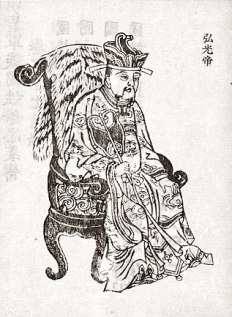
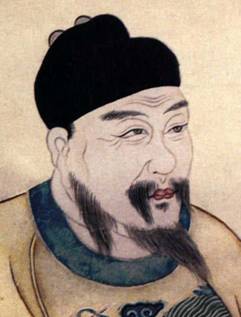
 Feeling
betrayed, Koxinga struck out on his own.
“In the past I was guided by my relatives,
but now I am alone.” (Clements, 133) He
also believed that he was entitled to
control the vast empire that his father
had created, although many within the
Zheng clan disagreed. As a result, Koxinga
had only one
Feeling
betrayed, Koxinga struck out on his own.
“In the past I was guided by my relatives,
but now I am alone.” (Clements, 133) He
also believed that he was entitled to
control the vast empire that his father
had created, although many within the
Zheng clan disagreed. As a result, Koxinga
had only one 
 His father
wrote two letters to Koxinga, saying the
Manchus wished to meet and discuss terms
of peace. The second missive included this
passage: “The Manchu court offers
territory in exchange for peace. They wish
to send two noblemen to present you with
the title and deeds of the Dukedom of
Haicheng, allowing your followers to abide
in the region.” (Clements, 149)
His father
wrote two letters to Koxinga, saying the
Manchus wished to meet and discuss terms
of peace. The second missive included this
passage: “The Manchu court offers
territory in exchange for peace. They wish
to send two noblemen to present you with
the title and deeds of the Dukedom of
Haicheng, allowing your followers to abide
in the region.” (Clements, 149)